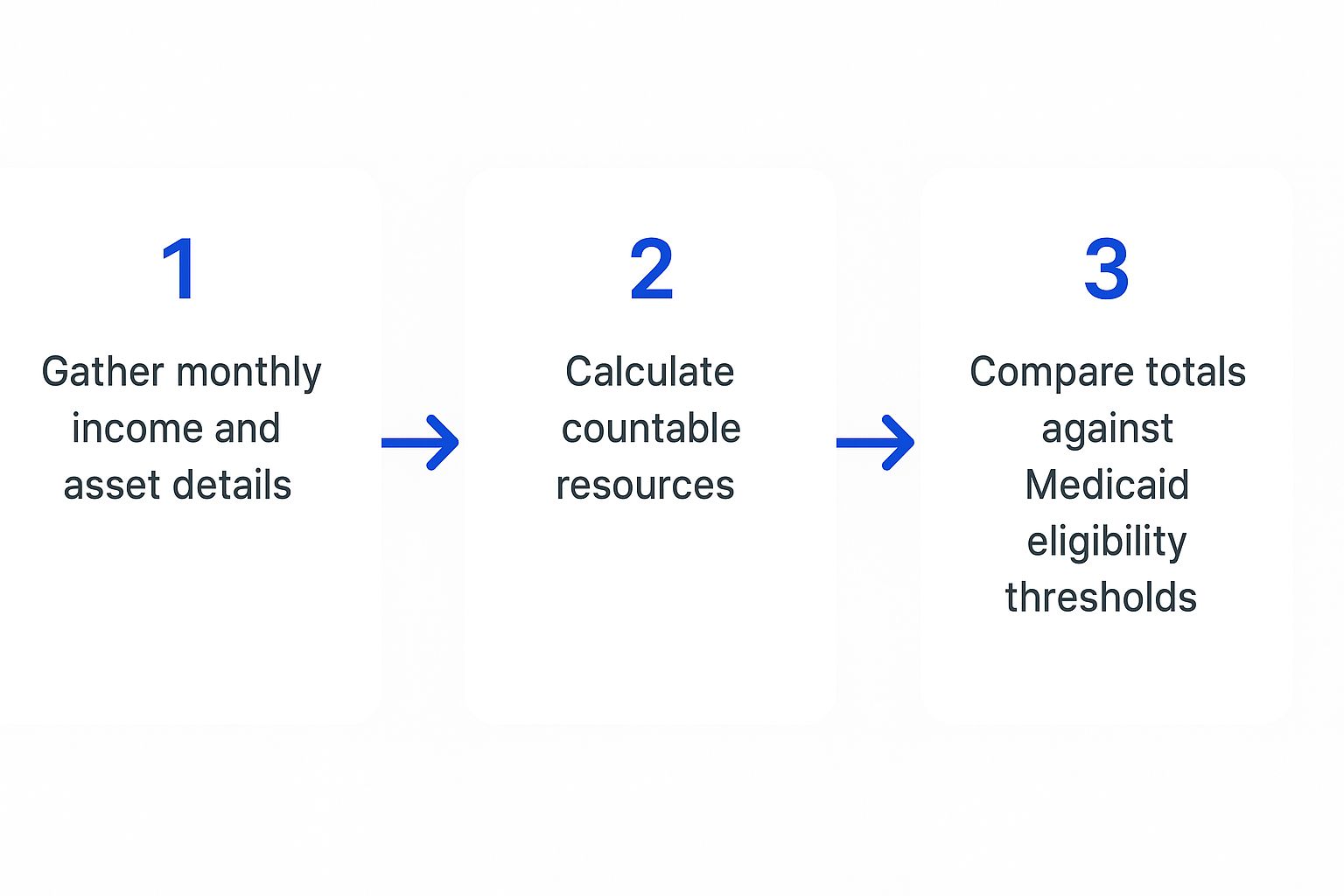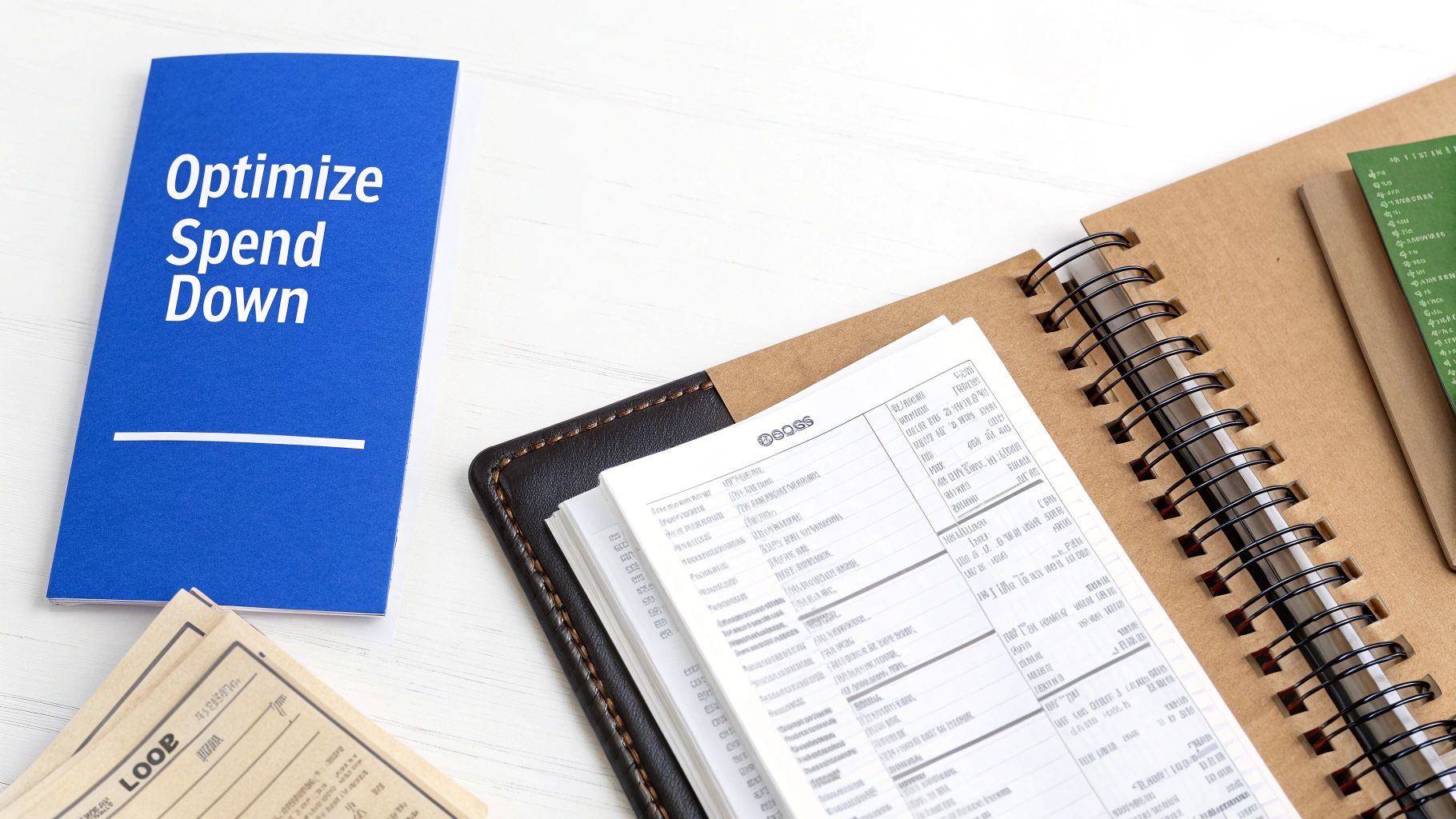When you hear the term Medicaid spend down calculator, it might sound complicated, but it's really just a tool to give you a clear, hard number. It estimates exactly how much of your "excess" income or assets you need to spend on medical care to finally qualify for Medicaid.
This is a lifesaver for people trying to figure out how to meet their state's specific financial limits for long-term care benefits.
What Is a Medicaid Spend Down, Really?
Trying to figure out Medicaid eligibility can feel like you're navigating a maze blindfolded, especially when your savings or income are just a little bit over the limit. This is where a Medicaid spend down comes in. It’s a completely legal and common strategy that lets you qualify by spending down those excess resources on approved medical costs.
Think of it as a bridge. It gets you the care you need without forcing you to lose every penny you've worked your life to save.
The whole process is about strategically reducing your "countable" assets or income to get under the strict financial caps set by your state. A good Medicaid spend down calculator cuts through the confusing state rules and your personal financial details to give you one simple number: your spend-down amount.
Countable vs. Non-Countable Assets
The heart of any spend-down calculation is knowing what assets Medicaid counts against you and which ones they ignore. Medicaid doesn't actually expect you to be left with nothing to get help. Certain assets are protected, while others are seen as available to pay for your care first.
Here are a few common examples of assets that usually do not count toward your limit:
- Your primary residence (up to a certain equity value, often $700,000 or more)
- One personal car or truck
- Your furniture, appliances, and other personal belongings
- A prepaid, irrevocable funeral plan
On the other hand, countable assets are the resources Medicaid expects you to use before they'll step in. This typically includes liquid assets like cash, money in checking and savings accounts, stocks, bonds, and that vacation cabin you own. These are the assets you’ll focus on when planning your spend down.
Key Takeaway: The goal isn't just to get rid of your money. It's to strategically convert countable assets into non-countable ones or use them on permissible expenses. For example, paying down your mortgage reduces your cash (a countable asset) but boosts the equity in your home (a non-countable asset).
To help you get a clearer picture, here’s a quick guide to what usually gets counted.
Common Countable vs Non-Countable Assets
| Asset Category | Usually Countable? | Specific Examples |
|---|---|---|
| Cash & Bank Accounts | Yes | Checking accounts, savings accounts, CDs, cash on hand |
| Real Estate | Depends | Primary home is usually non-countable (up to an equity limit). Vacation homes or rental properties are countable. |
| Vehicles | No | One personal vehicle is typically exempt. Additional cars, boats, or RVs are usually countable. |
| Investments | Yes | Stocks, bonds, mutual funds, 401(k)s, and IRAs (rules can vary by state) |
| Personal Property | No | Household furniture, clothing, jewelry (unless exceptionally valuable), appliances |
| Life Insurance | Depends | Policies with a cash surrender value over $1,500 are often countable. Term life insurance is not. |
| Prepaid Funerals | No | Irrevocable prepaid funeral contracts are typically exempt. |
This table is just a starting point, of course. The specific rules can get tricky and vary quite a bit from state to state.
For instance, the income and asset limits for a single person are often different than for a married couple. Special rules exist to protect the finances of the "community spouse" who is still living at home. To get into the nitty-gritty of these regulations, you can check out our comprehensive guide on Medicaid spend down rules. A calculator is so helpful because it applies these specific state-based rules to your financial situation, giving you a precise target to aim for.
Preparing Your Financials for an Accurate Calculation

A Medicaid spend-down calculator can be an incredibly powerful tool, but its results are only as good as the information you put into it. To get a truly accurate estimate, you have to roll up your sleeves and gather some specific financial documents. Think of this as a head start on the official Medicaid application—getting organized now will save you headaches later.
The first step is simply getting organized. I always suggest creating a simple system with three folders to keep everything straight: one for liquid assets, another for property documents, and a third for income statements. This makes it so much easier to find exactly what you need when you sit down to work through the numbers.
Valuing Your Assets Correctly
As you start gathering your documents, you'll find some assets are straightforward while others require a much closer look. It’s not just about listing what you own; it's about assigning the correct value that Medicaid will use in its assessment. Precision is everything here.
A classic example is life insurance. A policy only counts as an asset if it has a cash surrender value. Term life insurance doesn't count at all. You'll need the policy statement that clearly shows this cash value, which is often completely different from the face value of the policy.
Jointly owned property is another area that can get complicated. If you share a bank account with someone else, you'll need to prove who contributed the funds. Medicaid often assumes the applicant owns 100% of the money unless you can prove otherwise, so having crystal-clear records is essential.
Assembling Key Financial Documents
To make sure your calculation is as precise as possible, you’ll need to round up the most recent statements for every single financial account and asset you hold. This detailed list is the foundation of an accurate spend-down figure.
Your document checklist should include things like:
- Bank Statements: Grab at least three months of statements for all checking and savings accounts.
- Investment Records: Collect recent statements from any brokerage accounts, stocks, bonds, or mutual funds.
- Retirement Accounts: Find the latest statements for any 401(k)s, IRAs, or other retirement funds.
- Property Deeds: You'll need copies of deeds for any real estate you own, including your primary home.
- Vehicle Titles: Have the title for any cars, trucks, or other vehicles in your name ready to go.
- Life Insurance Policies: Get the policy document that lists the current cash surrender value.
A common oversight is forgetting about smaller assets like savings bonds or old CDs. Make sure to account for everything, because even small amounts can impact your eligibility calculation. Meticulous preparation now prevents surprises later.
Finally, you’ll need to track both your gross and net income from all sources. This includes Social Security benefits, pensions, and any other regular payments you receive. Having these figures ready will complete the financial picture needed for the calculator and set you up for a trustworthy result.
How to Use a Medicaid Spend Down Calculator
Once you've got all your financial paperwork in order, it's time to put a Medicaid spend down calculator to work. Think of these tools as a shortcut through the maze of state-specific rules. They take your real numbers and give you a straightforward, actionable goal to aim for.
Let's walk through how this plays out in two of the most common situations people face: having too many assets and having too much income.
We'll start with a classic asset scenario. Picture Jane, a single applicant living in a state with a $2,000 asset limit. After adding up her savings account and a few stocks, her total countable assets come to $17,000. She plugs that number into the calculator.
The calculator does one simple, yet critical, thing: it subtracts the state's asset limit from her total. The number left over is her spend-down amount. Suddenly, she knows exactly how much she needs to reduce her assets to become eligible.
Asset Spend Down Formula: Total Countable Assets – State Asset Limit = Spend Down Amount. For Jane, the math is $17,000 – $2,000 = $15,000. Now she has a precise target.
Calculating an Income Spend Down
Now, let's look at income. Meet John. He's in a state where the monthly income limit for Medicaid is $1,800. Between his pension and Social Security, his monthly income is $2,300, which puts him $500 over the line every month.
But John also has some hefty medical bills that aren't covered by his other insurance. He spends $600 each month on prescriptions and for a home health aide. When he enters both his income and these medical costs into the calculator, it flips the script.
The calculator subtracts his qualified medical expenses from his income, showing that his "countable" income for Medicaid is actually under the limit. For people like John with excess income, deducting those non-covered medical bills is one of the main ways to qualify. If you want to dig deeper into this, Elderplan.org has some great insights.
This infographic breaks down the basic flow of information when you're figuring out your spend-down amount.

As you can see, it's really just a matter of lining up your financial reality against the state's limits. It takes the guesswork out of the process and turns abstract rules into a solid financial plan.
From Calculation to Verification
Getting your spend-down number from a calculator is the first big step. The next is getting everything documented and ready for the official application. The tool gives you the target, but it's the state's Medicaid agency that will need to verify every last detail.
This is where all that time you spent gathering financial documents really pays off. Every asset and income source you punched into the calculator has to be backed up with an official statement or record.
You can get a better sense of what this involves in our guide on Medicaid coverage verification. Having your paperwork organized and ready to go will make the jump from calculation to application much smoother and help you avoid frustrating delays.
Smart Ways to Spend Down Your Assets Legally

So, your Medicaid spend-down calculation gave you a specific number. Now the real work begins: reaching that target legally and intelligently. The key is to do this without running afoul of the strict five-year "look-back" period, which penalizes you for improperly transferring assets.
This isn’t about just getting rid of money. It's about a strategic conversion of countable assets into non-countable ones or using them for permissible expenses that genuinely improve your quality of life.
I see people make the same mistake all the time—they just start giving money away to their kids. While the intention is good, cash gifts are a huge red flag for Medicaid. This can trigger a costly penalty period, delaying your eligibility for months or even years. Smart spending is all about making your resources work for you in a way that Medicaid allows.
Paying Down Debts and Prepaying for Future Needs
One of the most straightforward ways to reduce your countable assets is to get rid of any outstanding debt. Think about it: every dollar you use to pay off a legitimate bill is a dollar that's no longer sitting in your bank account, waiting to be counted against you.
This is a pretty broad category that can cover a lot of ground:
- Mortgage Payments: This is a fantastic strategy. You can make extra payments or even pay off the mortgage on your primary home entirely. You’re simply moving money from a countable asset (your bank account) into a non-countable one (your home equity).
- Credit Card Balances: High-interest credit card debt is a financial anchor. Wiping those balances clean is a perfectly acceptable way to spend down.
- Car Loans: Still have a loan on your personal vehicle? Paying it off is another easy and effective way to lower your countable resources.
Beyond tackling old debts, you can also prepay for future needs. A very common and accepted strategy is to set up an irrevocable prepaid funeral contract. This not only helps you meet the spend-down requirements but also takes a tremendous financial and emotional burden off your family later on.
Enhancing Your Quality of Life at Home
Spending down can—and should—directly improve your daily life. Making necessary modifications to your home is a powerful way to use your funds while staying compliant with the rules. These aren't just cosmetic upgrades; they are real investments in your safety, accessibility, and ability to stay independent.
Here are some practical examples I've seen clients use:
- Installing a walk-in shower or adding grab bars in the bathroom to prevent dangerous falls.
- Building a ramp for wheelchair access if stairs have become a problem.
- Replacing an old, inefficient heating or cooling system to make the home more comfortable and safe year-round.
- Purchasing a newer, more reliable car if the one you have is constantly breaking down.
A critical word of caution: Every single purchase or payment must be for fair market value. You can't "sell" your car to your grandson for $1. Medicaid will see right through that and treat it as a gift, which can trigger penalties. Always make sure your transactions are legitimate and well-documented.
Ultimately, the goal is to spend down in a way that provides you with tangible benefits. For a deeper dive into these strategies and more, our guide on protecting assets from nursing home costs offers some great additional insights. With careful planning, you can make sure every dollar helps you qualify for care and enhances your well-being.
Common Mistakes That Can Jeopardize Your Eligibility

Navigating the path to Medicaid eligibility really requires careful attention to detail. I’ve seen it happen too many times—one wrong move can lead to frustrating delays or even an outright denial of benefits. Understanding the common pitfalls is honestly the best way to make sure your journey is as smooth as possible.
The single biggest mistake people make involves Medicaid's five-year "look-back" period. This is a big one. This rule allows the state to scrutinize any assets you sold for less than they were worth or simply gave away in the five years before you apply.
Gifting money to your kids or grandkids, while it comes from a good place, can trigger a significant penalty period. This means Medicaid won't pay for your care for a certain number of months, forcing you to cover those high costs out of your own pocket.
Mismanaging Asset Transfers and Documentation
The look-back period exists to prevent applicants from basically making themselves look poor on paper just to qualify for benefits. Any transfer where you don't get fair market value in return is going to raise a major red flag.
Here’s a real-world scenario: a father "sells" his $20,000 car to his son for $1,000 about a year before he applies for Medicaid. The state will absolutely view that $19,000 difference as an improper gift and impose a penalty, which will delay his eligibility.
To avoid this, you have to steer clear of these common errors:
- Giving Away Cash: Any cash gifts to family or friends, no matter how small they seem, can become a problem.
- Selling Assets Below Value: Selling a home, car, or other property for less than its market value will be penalized.
- Adding Children to Bank Accounts: Simply putting a child's name on your bank account can be interpreted as a gift of those funds.
Crucial Tip: Document every single transaction during your spend-down process. Keep meticulous records of payments, receipts, and any formal agreements. If you pay a relative for care, you must have a written personal care contract that outlines their duties and establishes fair market compensation.
Overlooking Key Details and Deadlines
Beyond improper transfers, smaller oversights can also put your application at risk. Things like failing to properly document every approved expense, misclassifying an asset, or paying a family caregiver without a formal agreement can all create significant headaches.
The landscape of Medicaid is always shifting. Recent trends show fluctuations in enrollment, which just underscores how important it is to have meticulous financial planning for long-term care needs. Effective asset management is still the cornerstone of qualifying for benefits without facing severe financial strain. You can learn more about these Medicaid enrollment and spending trends to understand the bigger picture.
Ultimately, precision is your best defense. Double-check your numbers with a Medicaid spend down calculator, document every single expense, and make sure you understand the rules around gifting and asset transfers. This diligence is what ensures you avoid costly mistakes and secure the care you need without unnecessary delays.
Got Questions About Spend Down Calculators? We've Got Answers
Trying to figure out the Medicaid spend down process can feel like a maze, and it’s completely normal to have a lot of questions. A good Medicaid spend down calculator is a fantastic tool, but you might still be wondering about the finer details. We'll walk through some of the most common questions we hear to help you feel more confident about your next steps.
Our goal here is to pull back the curtain on these calculators and show you how to get the most out of them. Let's dive into the big ones.
Can I Use a Spend Down Calculator for Any State?
While most online calculators are a great starting point, you absolutely have to make sure the tool is using your specific state's income and asset limits. These numbers can be wildly different from one state to the next.
For example, a single person might have an asset limit of $2,000 in one state, but that number could be much higher just one state over. Think of an online calculator as a powerful estimation tool. When it's time for final planning, you must confirm the numbers with your state's Medicaid agency or an elder law attorney to be sure everything is spot-on.
What if the Calculator Shows I’m Already Eligible?
That’s fantastic news! If a calculator shows your finances are already within your state's limits, your very next move should be to start the official Medicaid application.
Pull together the same financial documents you used for the calculation—you'll need them to fill out the application accurately. Just remember, being eligible on paper is the first big hurdle. You still have to go through the state's verification process before you're officially approved for benefits.
Key Insight: A calculator showing you're eligible is a strong green light to apply, but it doesn't replace the application itself. The state agency always has the final say after verifying your documents.
How Often Should I Rerun the Calculation?
It's a smart move to use a Medicaid spend down calculator anytime you have a significant financial change. This keeps you ahead of the game and helps you avoid any surprises that could mess with your eligibility later on.
You should definitely run the numbers again if you:
- Receive an inheritance or a large cash gift
- Sell a house, car, or another major asset
- Have a change in your income from a pension, Social Security, or other sources
- Face a new, large, or ongoing medical expense
It’s also a good idea to re-check things annually. States sometimes tweak their eligibility limits, and staying current ensures your financial plan is still solid. You don't want to accidentally become ineligible for the care you rely on.
Navigating these rules can be tough, but you don't have to figure it all out by yourself. The dedicated team at NJ Caregiving is here to help you understand your in-home care options and guide you through the process. Explore our services at https://njcaregiving.com to see how we can support your family.


